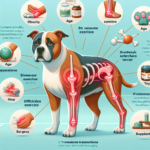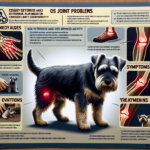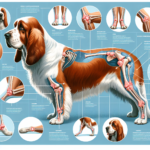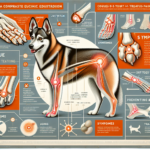Saint Bernard Joint Pain: Causes, Symptoms, Prevention, and Treatment
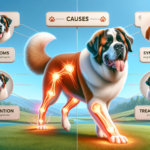
Introduction
The Saint Bernard is a giant breed known for its gentle demeanor, loyalty, and impressive size. Originating from the Swiss Alps, these dogs were initially bred by monks at the Saint Bernard Hospice to rescue travelers lost in the snow. With their keen sense of smell and robust build, Saint Bernards have saved countless lives, earning them a place in canine history. Today, they are cherished family pets and companions, known for their friendly and patient nature.
However, like many large breeds, Saint Bernards are prone to certain health issues, particularly those related to their joints. Joint pain is a significant concern for this breed, given their size and weight, which can place considerable stress on their joints. Understanding the causes, symptoms, prevention, and treatment of joint pain in Saint Bernards is crucial for ensuring their long-term health and well-being.
Joint health is particularly important for Saint Bernards due to their predisposition to joint-related issues and the impact these problems can have on their quality of life. Proper care and early intervention can help manage and mitigate the effects of joint pain, allowing these gentle giants to lead active and comfortable lives.
Breed-Specific Joint Pain Risks
Genetic Predisposition
Saint Bernards are genetically predisposed to several joint-related issues, including hip dysplasia, elbow dysplasia, and arthritis. Hip dysplasia is a condition where the hip joint does not fit properly into the hip socket, leading to pain and mobility issues. Elbow dysplasia involves abnormal development of the elbow joint, causing lameness and discomfort. Arthritis, a degenerative joint disease, is also common in this breed, particularly as they age.
Age-Related Risks
As Saint Bernards age, the risk of joint pain increases. The breed typically reaches senior status around 6-8 years of age, and it is during this time that joint issues often become more pronounced. Owners should be vigilant for signs of joint pain as their dog ages, as early detection and treatment can significantly improve the dog’s quality of life.
Activity Level and Joint Stress
Saint Bernards are not as high-energy as some other breeds, but their large size means that even moderate activity can place significant stress on their joints. Activities such as running, jumping, and climbing stairs can exacerbate joint issues. Additionally, Saint Bernards are often used as working dogs, which can further contribute to joint stress and wear over time.
Common Symptoms of Joint Pain in Saint Bernards
General Symptoms
- Limping or favoring one leg
- Stiffness, especially after rest
- Reluctance to move or climb stairs
- Decreased activity or playfulness
- Swelling around the joints
- Whining or showing signs of discomfort when touched
Breed-Specific Symptoms
In Saint Bernards, joint pain may manifest more noticeably due to their size. Owners may observe a pronounced limp or difficulty getting up from a lying position. The dog’s large frame can also make it more challenging to detect subtle signs of discomfort, so close observation is essential.
When to Consult a Vet
If a Saint Bernard shows any signs of joint pain, it is crucial to consult a veterinarian promptly. Early intervention can prevent further deterioration and improve the dog’s quality of life. Persistent limping, noticeable discomfort, or any sudden changes in mobility should be addressed by a professional.
Preventive Measures for Joint Health
Exercise Recommendations
Regular, low-impact exercise is essential for maintaining joint health in Saint Bernards. Activities such as walking, swimming, and gentle play can help keep the joints flexible and muscles strong without placing excessive stress on the joints. Avoid high-impact activities like jumping or running on hard surfaces.
Dietary Suggestions
A balanced diet rich in nutrients that support joint health is crucial for Saint Bernards. Foods containing glucosamine, chondroitin, and omega-3 fatty acids can help maintain joint function and reduce inflammation. Supplements specifically designed for joint health can also be beneficial, but it is essential to consult a veterinarian before adding any new supplements to the dog’s diet.
Weight Management
Maintaining a healthy weight is vital for reducing joint stress in Saint Bernards. Excess weight can exacerbate joint issues and lead to more severe pain and mobility problems. Owners should monitor their dog’s weight closely and adjust their diet and exercise routine as needed to keep them at an optimal weight.
Early Screening and Monitoring
Regular veterinary check-ups and early screening for joint issues can help catch problems before they become severe. X-rays and other diagnostic tools can identify joint abnormalities early, allowing for timely intervention. Owners should also monitor their dog’s behavior and mobility for any signs of discomfort or changes.
Treatment Options for Joint Pain
Non-Surgical Treatments
Non-surgical treatments for joint pain in Saint Bernards include medications, physical therapy, and lifestyle adjustments. Anti-inflammatory drugs and pain relievers can help manage pain and reduce inflammation. Physical therapy, including exercises and massage, can improve joint function and mobility. Lifestyle adjustments, such as providing a comfortable bed and avoiding stairs, can also alleviate joint stress.
Surgical Options
In severe cases, surgical intervention may be necessary to address joint pain in Saint Bernards. Common surgeries include hip replacement, elbow surgery, and arthroscopy. These procedures can significantly improve the dog’s quality of life, but they come with risks and require a thorough discussion with a veterinarian.
Alternative Therapies
Alternative treatments such as acupuncture, hydrotherapy, and massage can also benefit Saint Bernards with joint pain. Acupuncture can help reduce pain and inflammation, while hydrotherapy provides low-impact exercise that strengthens muscles without stressing the joints. Massage can improve circulation and reduce muscle tension, providing relief from joint pain.
Lifestyle and Management Tips
Daily Care Routine
A daily care routine for a Saint Bernard with joint pain should include gentle exercise, a balanced diet, and regular monitoring for signs of discomfort. Short, frequent walks and low-impact activities like swimming can help maintain joint health. Providing a comfortable, supportive bed and avoiding stairs can also reduce joint stress.
Modifying the Home Environment
Making the home environment more comfortable for a Saint Bernard with joint pain can significantly improve their quality of life. Consider using ramps instead of stairs, providing orthopedic beds, and ensuring that food and water bowls are at a comfortable height. Non-slip mats can also help prevent falls and reduce joint strain.
Long-Term Management
Long-term management of joint pain in Saint Bernards involves regular veterinary check-ups, ongoing monitoring, and adjustments to the dog’s care routine as needed. Maintaining a healthy weight, providing appropriate exercise, and using medications or supplements as prescribed can help manage joint pain and keep the dog active and happy.
FAQs About Saint Bernards and Joint Pain
What are the early signs of joint pain in Saint Bernards?
Early signs of joint pain in Saint Bernards include limping, stiffness, reluctance to move, and decreased activity. Owners should watch for any changes in mobility or behavior that may indicate discomfort.
Can joint pain in Saint Bernards be prevented?
While joint pain cannot always be prevented, early intervention, proper care, and preventive measures such as maintaining a healthy weight, providing appropriate exercise, and using joint supplements can help reduce the risk and severity of joint issues.
Are there specific diets that can help with joint health in Saint Bernards?
Yes, diets rich in glucosamine, chondroitin, and omega-3 fatty acids can support joint health in Saint Bernards. Consult a veterinarian for recommendations on the best diet and supplements for your dog.
When should I consult a vet about my Saint Bernard’s joint pain?
If your Saint Bernard shows any signs of joint pain, such as limping, stiffness, or reluctance to move, it is essential to consult a veterinarian promptly. Early diagnosis and treatment can significantly improve the dog’s quality of life.
What are the surgical options for severe joint pain in Saint Bernards?
Surgical options for severe joint pain in Saint Bernards include hip replacement, elbow surgery, and arthroscopy. These procedures can provide significant relief but require careful consideration and discussion with a veterinarian.
Conclusion
Joint pain is a common concern for Saint Bernards, given their size and genetic predisposition to joint issues. Understanding the causes, symptoms, prevention, and treatment options is crucial for ensuring the long-term health and well-being of these gentle giants. By taking preventive measures, providing appropriate care, and consulting a veterinarian regularly, owners can help their Saint Bernards lead active and comfortable lives despite joint pain.

